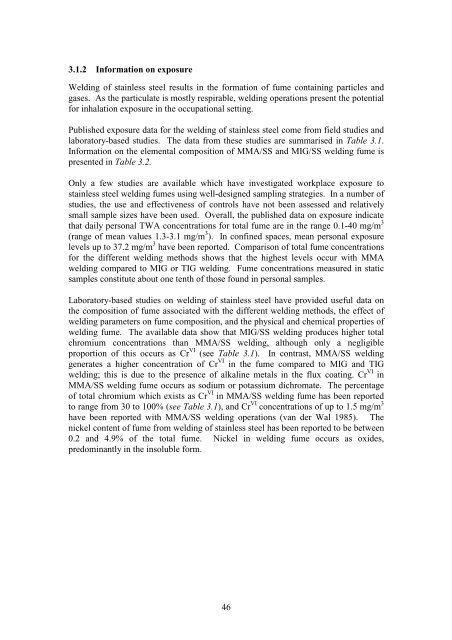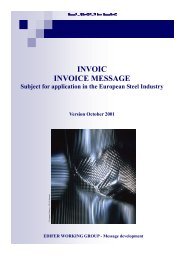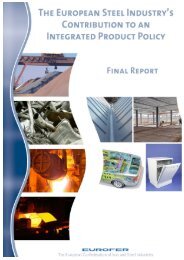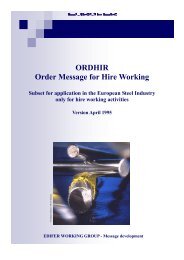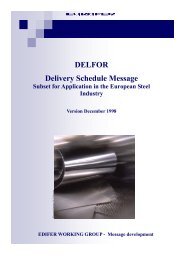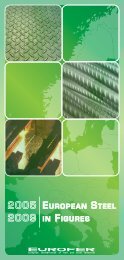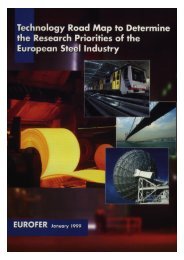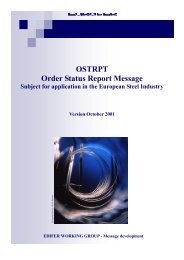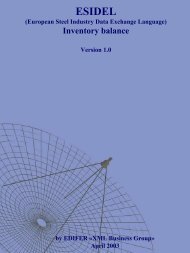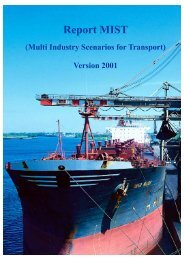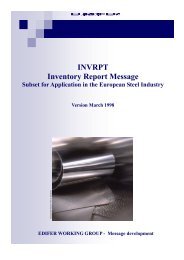manufacture, processing and use of stainless steel - International ...
manufacture, processing and use of stainless steel - International ...
manufacture, processing and use of stainless steel - International ...
Create successful ePaper yourself
Turn your PDF publications into a flip-book with our unique Google optimized e-Paper software.
3.1.2 Information on exposure<br />
Welding <strong>of</strong> <strong>stainless</strong> <strong>steel</strong> results in the formation <strong>of</strong> fume containing particles <strong>and</strong><br />
gases. As the particulate is mostly respirable, welding operations present the potential<br />
for inhalation exposure in the occupational setting.<br />
Published exposure data for the welding <strong>of</strong> <strong>stainless</strong> <strong>steel</strong> come from field studies <strong>and</strong><br />
laboratory-based studies. The data from these studies are summarised in Table 3.1.<br />
Information on the elemental composition <strong>of</strong> MMA/SS <strong>and</strong> MIG/SS welding fume is<br />
presented in Table 3.2.<br />
Only a few studies are available which have investigated workplace exposure to<br />
<strong>stainless</strong> <strong>steel</strong> welding fumes using well-designed sampling strategies. In a number <strong>of</strong><br />
studies, the <strong>use</strong> <strong>and</strong> effectiveness <strong>of</strong> controls have not been assessed <strong>and</strong> relatively<br />
small sample sizes have been <strong>use</strong>d. Overall, the published data on exposure indicate<br />
that daily personal TWA concentrations for total fume are in the range 0.1-40 mg/m 3<br />
(range <strong>of</strong> mean values 1.3-3.1 mg/m 3 ). In confined spaces, mean personal exposure<br />
levels up to 37.2 mg/m 3 have been reported. Comparison <strong>of</strong> total fume concentrations<br />
for the different welding methods shows that the highest levels occur with MMA<br />
welding compared to MIG or TIG welding. Fume concentrations measured in static<br />
samples constitute about one tenth <strong>of</strong> those found in personal samples.<br />
Laboratory-based studies on welding <strong>of</strong> <strong>stainless</strong> <strong>steel</strong> have provided <strong>use</strong>ful data on<br />
the composition <strong>of</strong> fume associated with the different welding methods, the effect <strong>of</strong><br />
welding parameters on fume composition, <strong>and</strong> the physical <strong>and</strong> chemical properties <strong>of</strong><br />
welding fume. The available data show that MIG/SS welding produces higher total<br />
chromium concentrations than MMA/SS welding, although only a negligible<br />
proportion <strong>of</strong> this occurs as Cr VI (see Table 3.1). In contrast, MMA/SS welding<br />
generates a higher concentration <strong>of</strong> Cr VI in the fume compared to MIG <strong>and</strong> TIG<br />
welding; this is due to the presence <strong>of</strong> alkaline metals in the flux coating. Cr VI in<br />
MMA/SS welding fume occurs as sodium or potassium dichromate. The percentage<br />
<strong>of</strong> total chromium which exists as Cr VI in MMA/SS welding fume has been reported<br />
to range from 30 to 100% (see Table 3.1), <strong>and</strong> Cr VI concentrations <strong>of</strong> up to 1.5 mg/m 3<br />
have been reported with MMA/SS welding operations (van der Wal 1985). The<br />
nickel content <strong>of</strong> fume from welding <strong>of</strong> <strong>stainless</strong> <strong>steel</strong> has been reported to be between<br />
0.2 <strong>and</strong> 4.9% <strong>of</strong> the total fume. Nickel in welding fume occurs as oxides,<br />
predominantly in the insoluble form.<br />
46


